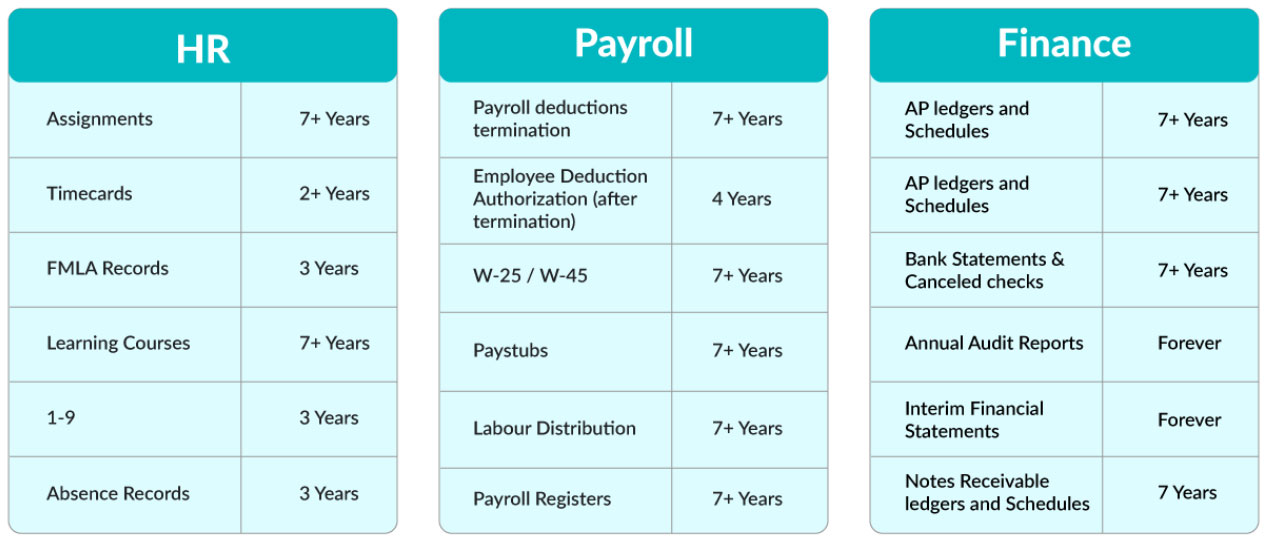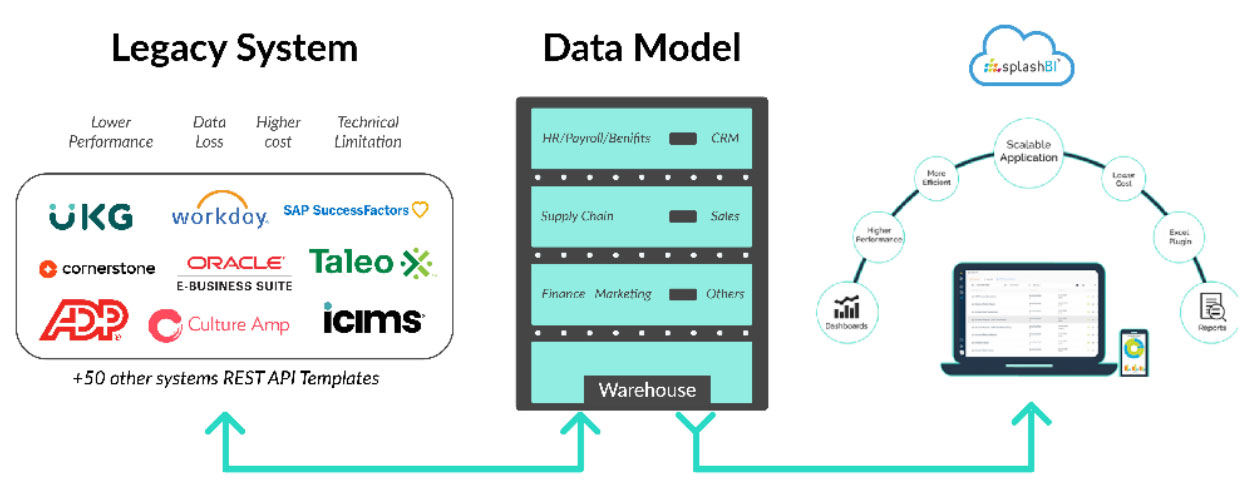As we transition to a new HRIS system, it’s crucial to address not just people and process changes but also our approach to legacy data. The success of an HCM migration heavily relies on a well-thought-out legacy data strategy. Questions about where to store old data, who will manage it, and how to access it are vital. While new vendors may offer to import historical data, it’s important to recognize that this data may not be identical in format or content to the current system, underscoring the need for a strategic plan for your historical data.
This blog delves into the HRIS migration process with a focus on all things “data” – historical data, data continuity, integration, data governance, etc.- and highlights the significant influence of data analytics and reporting solutions on transforming this journey.
The Requirement for HR Data Migration
Recognizing Data Migration Needs
When assessing Data migration needs, focus on both future and historical data requirements. Consider what the new system needs to handle—input, output, reporting, integration—and the management of historical data, including reporting, governance, security, and access. Ensure the data is actionable, prioritizing essential needs over ‘nice-to-haves’ to stay forward-looking and strategic in your migration approach.
Data-Driven Decision-Making
Leveraging data for decision-making is crucial. Many great Leaders have relied on intuition and subjective insights using the data available to them, but advances in technology have made extensive analytics accessible to organizations of all sizes. Integrating a powerful BI solution with your HRIS technology stack can amplify your ability to make data-driven insights with minimal manual effort, enabling data-driven strategies that enhance operational efficiency and employee satisfaction. See how a retail chain saw that migrating to a cloud-based HRIS integrated with SplashBI experienced a 40% reduction in HR operational costs and a 25% increase in employee satisfaction within the first year post-migration in a limited data retention timeframe. Prioritizing data over intuition can substantially improve organizational processes and outcomes.
Data Retention Timeframe Sample
From a historical data perspective, businesses maintain retention schedules for different functions, with specific timeframes that dictate how long a typical organization must keep historical records such as HR, Payroll and Financial data. It’s important to consider your data governance policy (disposition and retention requirements as well as who/how these policies will be upheld) when planning for your historical data migration. Make sure the data migrated is compliant, and in a format that you can easily maintain compliance in the future.

Assessing Organizational Readiness
Evaluating Readiness
Migration readiness encompasses a spectrum of considerations, from technical infrastructure and staff readiness to data integrity. One of the most significant components of evaluating readiness is outlining why you are considering migrating to a new platform. What are the current issues or concerns, and what do you hope to get out of the new application? Integrating data analytics tools should be a key consideration, offering insights into the efficiency and effectiveness of the migration process itself.
Challenges and Solutions
Anticipating potential hurdles, such as data loss and employee resistance, is crucial. User adoption, along with employee engagement is critical for the success of the migration. Keeping the end users in mind should be at the forefront of the decisions that are made. Here , BI platforms can play a pivotal role in data validation and employee engagement analytics, offering insights into staff sentiments and training effectiveness, thus ensuring a smoother transition.
Streamlining the Migration Process
Effective Migration Process
A successful migration strategy is underpinned by clear objectives, careful selection of a compatible HRIS, and stakeholder involvement. Taking inventory of the information that you currently have and identifying which data should be moved forward is crucial. Historical data, along with your new data, will help you make informed decisions after you go live on your new system. Predictive analytics will help guide decision-making and ensure a tailored migration approach.
Real-World Application
Leveraging SplashBI’s analytics capabilities, a healthcare provider was able to identify key data migration paths ensuring business continuity and staff productivity.
Legacy data
Legacy data is crucial to making future business decisions. Irrespective of the system of record you may be moving from, that is Oracle EBS, PeopleSoft, JD Edwards, etc, you will need access to this data for your analytics and reporting needs, compliance and data retention requirements based on local regulations.
SplashBI’s unique solution provides a cost-effective alternative for managing your Enterprise Historical Data needs. It not only gives you the raw data but also helps you transform it into meaningful insights and provides out-of-the-box compliance reports.

Ensuring Data Integrity and Continuity
Data Strategy and Continuity
Legacy data handling is a cornerstone of migration, necessitating meticulous cleaning, mapping, and transformation efforts. BI platforms for HR enhance this step with their data cleansing and validation features, ensuring that the migrated data is accurate, complete, and ready for use in the new system.
Post-Migration Reporting
After the migration is completed, the focus shifts to maximizing the new system’s capabilities. This is a good time to look back to the original goals and objectives of the project and ensure they were met, and also looking forward to taking the time to ensure the data is kept up to date and accurate. Some organizations have project fatigue and simply go back to how things were, not leveraging all the tools at their disposal. Staying focused on the product and its abilities will ensure the reporting is accurate and useful.BI reporting tools for HR enable organizations to delve deeper into HR analytics, offering insights into workforce efficiency, talent management, and predictive trends. For example, companies have reported up to a 30% improvement in talent retention rates by utilizing SplashBI’s reporting features for post-migration talent analytics.
Sample Use Case
Large Real estate company – archiving data for more than 30,000 employees.
- Huge Cost savings
- Easy access to W2, I9, Expense Reports, Invoices, and other enterprise documents
- Query historical data for inquiries from the legal department
- Compliance to keep 7+ years of HR/ Payroll and Finance data
- Historical HR and Payroll data store for all acquired companies
Conclusion
The path to a new HRIS is a transformation journey, offering organizations an opportunity to redefine their HR capabilities. Through careful planning, strategic execution, and the integration of powerful analytics tools, businesses can successfully navigate the complexities of HRIS migration. The benefits are clear: enhanced operational efficiency, data-driven strategic decision-making, and a robust platform for future growth.
As we move forward, the experiences and insights shared by those who have navigated this path are invaluable. We encourage you to explore how SplashBI can uplift your legacy data strategy during your HRIS migration experience and invite you to share your journey with us. The decision to migrate your HRIS is monumental and, when done correctly, can significantly enhance your organization’s efficiency and data management capabilities.
Our fantastic panel session with Data Migration Industry Experts is essential for HR professionals, IT specialists involved in HR processes, and business leaders looking to optimize their human resources information systems. Whether you are a decision-maker, a project manager, or an HR enthusiast keen on leveraging technology for HR excellence, this session will offer valuable insights and actionable strategies. Don’t miss this opportunity to transform your HRIS migration into a strategic advantage for your organization. Reserve your spot for our 27th March panel session and step confidently into the future of HR technology.
For more information and to register, click here.

Christina Crowley
Channel Partner Sales Manager, SplashBI

Laura Guary
Senior Vice President of Sales, Align HCM

Adrian Rocha
Manager, Executive Relationships, UKG













